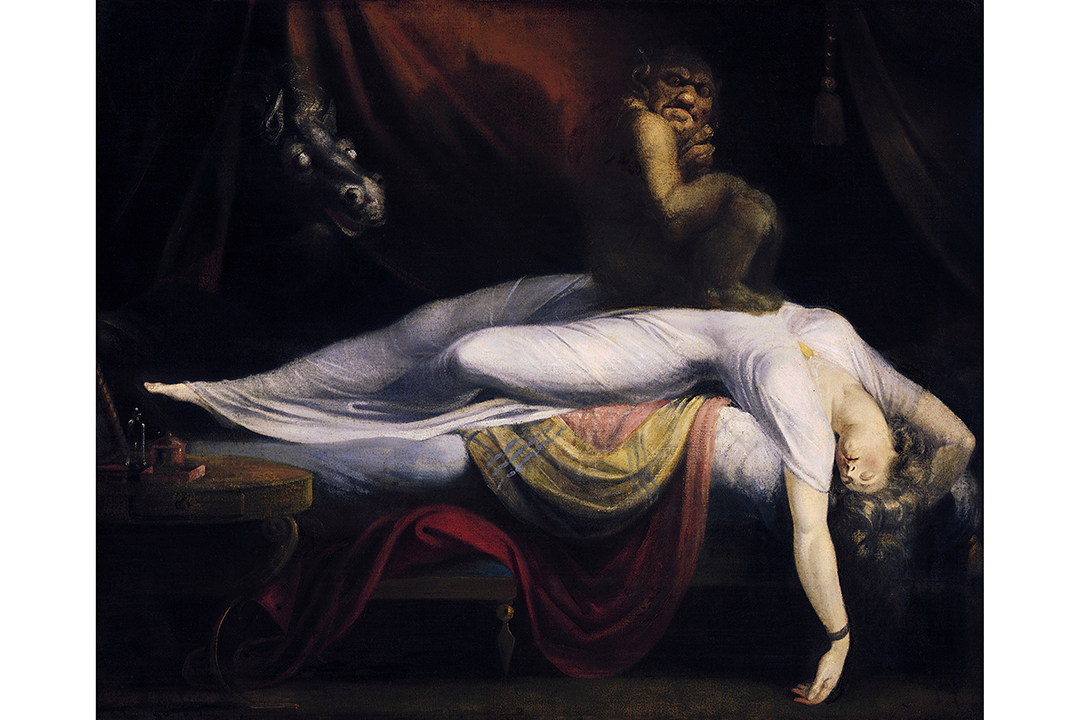You open your eyes and you’re sweating. It’s dark in your room. What time is it? You feel the strangest sensation in your chest — like something’s on top of you, holding you down. You’re wide awake and you can look around. Your heart’s beating fast. You want to make a run for it, but your legs aren’t moving. You feel everything — and yet you’re paralyzed.
Wait, did you hear that? You want to say something, but you can’t do that either. You hear the door creak open, and you sense that something’s approaching.
BOO!
Admittedly, spooking people doesn’t quite work as well with words alone. I’m sure Stephen King would be disappointed in my attempt.
“Uh, what was that all about?” I hear you ask. Well, around 300 years ago, this late night story of terror was classic folklore. Some believed that experiences like this were caused by a demonic creature haunting people in their sleep. These days, the experience is known as sleep paralysis, and it may still involve making acquaintances with a “sleep paralysis demon.”
Is it worth losing sleep over demons?
The notion that demons exist and are a part of our world — tormenting us, wreaking havoc, and stealing a sock from time to time — has been a commonly held belief in many religions and cultures for centuries. In fact, for many, such traditional beliefs are perfectly sufficient to explain instances of abnormal human behaviours like sleep paralysis.
Interestingly, there is a scientific explanation for the feeling of that demonic presence. In the spirit of Halloween, we’re going to take a look at how sleep paralysis demons ‘manifest’ in real life.
So, what is going on with those sleep paralysis demons? Are they real?
If you’re lucky enough to find some time away from studying for your midterms — which are terrifying in their own right — and get some sleep, you will most likely have a few dreams. We experience dreams during the deepest stage of our sleep cycle, called the rapid eye movement (REM) stage. Because our dreams can get intense, the brain protects the body during REM by temporarily paralyzing it, in order to prevent extraneous and possibly dangerous movements.
Sleep paralysis happens when we become conscious during REM — aware of our surroundings and yet immobile. There’s no demon holding us down, unless we define “demon” to mean “self-imposed suppression of skeletal muscle tone and neurons in the spinal cord.”
“But what about the demon I can still see having a tea party in my room?” you might ask.
This is where dreaming comes in. The demon and the tea party are both dream-like hallucinations we experience during REM. These hallucinations are known as ‘hypnagogic’ if they occur when the individual is falling asleep or ‘hypnopompic’ if they occur when the individual is waking up. They can be auditory, visual, or both, and can seem very real and scary.
Sleep paralysis affects anywhere from approximately 1.7 to 40 per cent of the general population, and it can be caused by sleep deprivation and stress. That adds up to a lot of demons coming out every night — or, as I like to put it, a lot of fatigued university students desperately trying to get some sleep.
Possessing the mind
Besides influencing people’s behaviours and mental states, demons are believed to be able to possess individuals as well. The popularity of the notion of demonic possessions has even encouraged people to ignore symptoms of psychiatric disorders — hallucinations, delusions, and interactions with things that are not there — by influencing individuals to try religious solutions such as exorcism.
Today, many classic symptoms of ‘demonic possession’ are actually associated with schizophrenia, which, according to the World Health Organization, is “a type of mental illness characterized by distortions in thinking, perception, emotions, language, sense of self and behaviour.”
Additionally, for hundreds of years, left-handed people were believed to have been involved in witchcraft and demonic practices, and deemed to be evil — yet Leonardo Da Vinci, perhaps the greatest painter of all time, was left-handed.
We may not be certain of many things — for instance, how exactly handedness is established — but we know that left-handed people aren’t secretly spending their time wearing black robes and witching away. We know that there is always some science behind supposed ‘demons’ — science which we will eventually be able to discover and explore, just as we have with sleep paralysis and mental illnesses like schizophrenia.
Evidently, life is complex and full of mysteries still unsolved, but it’s probably not full of creepy demons. You can rest easy knowing that dressing up as a demon for Halloween is about as real as it gets — as far as our natural world is considered, anyway. Or, at least, I hope so.
I hope my sleep paralysis demon doesn’t read this.


